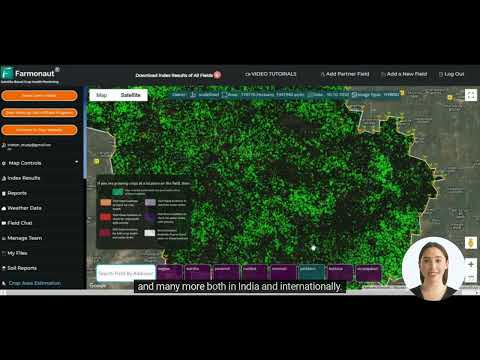Unlocking Agribusiness Potential: Australian Oilseeds vs Bunge Global Stock Analysis
“Australian Oilseeds (NASDAQ:COOT) and Bunge Global (NYSE:BG) are major players in the $120 billion global oilseeds market.”

In the ever-evolving landscape of agribusiness, investors are constantly seeking opportunities to maximize their returns while navigating the complexities of the global food supply chain. Today, we delve into a comprehensive stock analysis of two major players in the oilseeds and agribusiness sector: Australian Oilseeds (NASDAQ:COOT) and Bunge Global (NYSE:BG). As we unlock the potential of these consumer staples companies, we’ll explore their performance, institutional ownership, revenue generation, and stock volatility to provide valuable insights for investors and industry enthusiasts alike.
The Oilseed Giants: An Overview
Australian Oilseeds and Bunge Global stand as titans in the global oilseeds market, each carving out significant niches in the production, processing, and distribution of essential agricultural commodities. Before we dive into the nitty-gritty of their financial performance, let’s set the stage with a brief introduction to these agribusiness powerhouses.
Australian Oilseeds (NASDAQ:COOT)
Australian Oilseeds Holdings Ltd. is a relative newcomer to the public markets, having been founded on December 29, 2022. Despite its youth as a publicly-traded entity, the company has quickly established itself as a significant player in the oilseed industry. Headquartered in Cootamundra, Australia, the company focuses on the manufacture and sale of oilseeds through its subsidiaries. Its strategic location in Australia, known for its vast agricultural lands and favorable climate for oilseed cultivation, positions it well in the global market.
Bunge Global (NYSE:BG)
In contrast, Bunge Global SA boasts a rich history dating back to 1818, making it one of the oldest and most established companies in the agribusiness sector. Headquartered in Chesterfield, Missouri, Bunge operates on a truly global scale, with a presence in over 40 countries. The company’s operations span four primary segments: Agribusiness, Refined and Specialty Oils, Milling, and Sugar and Bioenergy. This diversification allows Bunge to maintain a strong foothold across various aspects of the agricultural value chain.
Institutional Ownership: A Tale of Two Strategies
“Institutional investors own approximately 13% of Australian Oilseeds’ stock, compared to 86.2% for Bunge Global.”
One of the most telling indicators of a company’s market perception and potential for growth is its level of institutional ownership. In this regard, Australian Oilseeds and Bunge Global present starkly different profiles.
Australian Oilseeds’ Ownership Structure
- Institutional Ownership: 13.0%
- Insider Ownership: 57.7%
The relatively low institutional ownership of Australian Oilseeds could be interpreted in several ways. On one hand, it might suggest that large money managers and hedge funds are still in the process of evaluating the company’s long-term potential, given its recent entry into the public markets. On the other hand, the high insider ownership (57.7%) demonstrates a strong belief in the company’s future by those most intimately familiar with its operations and strategy.
Bunge Global’s Ownership Structure
- Institutional Ownership: 86.2%
- Insider Ownership: 0.6%
The high institutional ownership of Bunge Global shares paints a picture of a company that has earned the confidence of sophisticated investors. With 86.2% of shares held by institutions, it’s clear that hedge funds, endowments, and other large money managers see significant value and growth potential in Bunge’s business model and market position. The lower insider ownership is not uncommon for a company of Bunge’s size and maturity, as executives often diversify their personal holdings over time.
This stark contrast in ownership structures offers valuable insights into the market’s perception of these two companies. While Australian Oilseeds may present an opportunity for investors looking to get in early on a company with high insider confidence, Bunge Global offers the stability and validation that comes with significant institutional backing.
Revenue Generation and Market Position
To truly understand the financial health and market position of Australian Oilseeds and Bunge Global, we need to examine their revenue generation capabilities and key financial metrics.
| Company Name | Stock Symbol | Price-to-Sales Ratio | Earnings per Share | Institutional Ownership % | Revenue (in billions USD) | Stock Volatility (Beta) |
|---|---|---|---|---|---|---|
| Australian Oilseeds | NASDAQ:COOT | 1.44 | N/A | 13.0% | 0.02212 | -0.18 |
| Bunge Global | NYSE:BG | 0.19 | 8.08 | 86.2% | 53.11 | 0.69 |
Australian Oilseeds: A Growing Force
With reported revenue of $22.12 million, Australian Oilseeds is still in its growth phase. The company’s price-to-sales ratio of 1.44 suggests that investors are willing to pay a premium for its shares relative to its sales, indicating expectations of future growth. However, the negative net income of $14.21 million highlights the challenges faced by the company as it seeks to establish itself in the competitive oilseeds market.
Bunge Global: A Revenue Powerhouse
Bunge Global’s revenue of $53.11 billion dwarfs that of Australian Oilseeds, showcasing the company’s dominant position in the global agribusiness sector. With a price-to-sales ratio of 0.19, Bunge’s stock appears undervalued relative to its sales, potentially offering an attractive entry point for value investors. The company’s strong earnings per share of $8.08 and net income of $2.24 billion further underscore its financial health and market leadership.
The vast difference in revenue scale between these two companies reflects their different stages in the business lifecycle. While Bunge Global leverages its established global presence and diversified operations to generate substantial revenue, Australian Oilseeds is focused on carving out its niche and scaling its operations in the competitive oilseeds market.
Stock Volatility and Risk Assessment
Understanding the volatility of a stock is crucial for investors seeking to balance risk and reward in their portfolios. Let’s examine how Australian Oilseeds and Bunge Global compare in terms of stock volatility:
Australian Oilseeds: Low Volatility Anomaly
Australian Oilseeds boasts a beta of -0.18, indicating that its stock price is 118% less volatile than the S&P 500. This unusually low beta for a relatively new and growing company in the agricultural sector is intriguing. It could suggest that the stock is not yet widely traded or that it moves independently of broader market trends. While this low volatility might appeal to risk-averse investors, it’s essential to consider whether it accurately reflects the company’s true risk profile given its early stage and negative net income.
Bunge Global: Moderate Volatility
With a beta of 0.69, Bunge Global’s stock exhibits 31% less volatility than the S&P 500. This moderate volatility level is more in line with what one might expect from an established player in the consumer staples sector. It suggests that while Bunge’s stock price does respond to market movements, it tends to do so with less dramatic swings, potentially offering a balance of growth opportunity and relative stability.
The contrast in volatility between these two stocks highlights the importance of considering a company’s market position, maturity, and overall financial health when interpreting beta values. While Australian Oilseeds’ low beta might seem attractive at first glance, investors should weigh this against the company’s growth stage and financial performance. Conversely, Bunge Global’s moderate volatility, combined with its strong financial metrics, may offer a more balanced risk-reward profile for many investors.
Analyst Ratings and Future Outlook
When it comes to making informed investment decisions, analyst ratings can provide valuable insights into a stock’s potential performance. Let’s examine how analysts view Australian Oilseeds and Bunge Global:
Australian Oilseeds: Limited Coverage
As a relatively new entrant to the public markets, Australian Oilseeds currently has limited analyst coverage. This lack of extensive analysis is not uncommon for smaller, newer companies and presents both challenges and opportunities for investors:
- Opportunity for Independent Research: The lack of extensive analyst coverage means that diligent investors might uncover value that the broader market has not yet recognized.
- Higher Risk: Limited analyst coverage also means less scrutiny and fewer professional opinions to guide investment decisions, potentially increasing risk.
Bunge Global: Strong Analyst Interest
Bunge Global, on the other hand, enjoys significant analyst attention, reflecting its status as a major player in the agribusiness sector:
- Consensus Rating: Hold
- Buy Ratings: 1
- Strong Buy Ratings: 1
- Hold Ratings: 3
- Sell Ratings: 0
- Consensus Price Target: $93.00
The analyst consensus for Bunge Global suggests a cautiously optimistic outlook. With a consensus price target of $93.00, analysts see a potential upside of 31.85% from current levels. This positive outlook is balanced by the majority “Hold” rating, indicating that while analysts see value in Bunge, they also recognize potential challenges or uncertainties in the near term.
Sector Trends and Growth Drivers
To fully appreciate the potential of Australian Oilseeds and Bunge Global, it’s crucial to understand the broader trends and growth drivers in the agribusiness and oilseeds sectors:
1. Rising Global Demand for Vegetable Oils
The global demand for vegetable oils continues to rise, driven by population growth, increasing per capita consumption in developing countries, and the expanding use of vegetable oils in biofuels. This trend benefits both Australian Oilseeds and Bunge Global, though their scale and market positioning affect how they can capitalize on this growth.
2. Biofuel Production and Renewable Energy
The push for renewable energy sources has led to increased demand for oilseeds in biofuel production. Bunge Global, with its dedicated Sugar and Bioenergy segment, is well-positioned to benefit from this trend. Australian Oilseeds, while smaller, may find opportunities to supply raw materials to this growing market.
3. Technological Advancements in Agriculture
Innovations in farming techniques, precision agriculture, and crop genetics are improving yields and efficiency in oilseed production. Companies that can leverage these technologies effectively may gain a competitive edge. This is an area where both companies could potentially differentiate themselves.
4. Shifting Consumer Preferences
Growing health consciousness and demand for plant-based proteins are driving innovation in oilseed-derived products. This trend presents opportunities for both companies to expand their product offerings and tap into new markets.
5. Global Trade Dynamics
International trade policies, tariffs, and geopolitical events can significantly impact the oilseeds market. Bunge Global’s global presence may provide it with more flexibility to navigate these challenges, while Australian Oilseeds’ focus on the Australian market could be both a strength and a limitation depending on global trade dynamics.
Comparative Strengths and Challenges
As we continue our analysis of Australian Oilseeds and Bunge Global, it’s important to highlight the unique strengths and challenges each company faces in the competitive agribusiness landscape.
Australian Oilseeds (NASDAQ:COOT)
Strengths:
- Geographic Advantage: Australia’s favorable climate for oilseed cultivation provides a natural advantage.
- High Insider Ownership: Suggests strong confidence from those most familiar with the company’s operations.
- Growth Potential: As a newer entrant, there may be significant room for expansion and market share growth.
- Niche Focus: Specialization in oilseeds could allow for targeted expertise and efficiency.
Challenges:
- Limited Scale: Smaller revenue base compared to global giants like Bunge.
- Financial Performance: Current negative net income indicates the need for improved profitability.
- Market Recognition: Lower institutional ownership suggests the company is still building its reputation among large investors.
- Geographic Concentration: Potential vulnerability to regional economic or environmental factors affecting Australia.
Bunge Global (NYSE:BG)
Strengths:
- Global Presence: Operations in over 40 countries provide diversification and market access.
- Diversified Portfolio: Multiple segments (Agribusiness, Refined Oils, Milling, Sugar and Bioenergy) offer balanced revenue streams.
- Financial Stability: Strong revenue and positive earnings demonstrate financial health.
- Market Leadership: Established position as a major player in the global agribusiness sector.
Challenges:
- Market Saturation: As an established player, finding new growth avenues may be challenging.
- Commodity Price Volatility: Exposure to fluctuations in global commodity prices across multiple sectors.
- Regulatory Complexity: Operating in numerous countries increases regulatory and compliance challenges.
- Environmental Concerns: Increased scrutiny on large agribusinesses regarding sustainability practices.
“Institutional investors own approximately 13% of Australian Oilseeds’ stock, compared to 86.2% for Bunge Global.”

Investment Considerations
When evaluating Australian Oilseeds and Bunge Global as potential investments, several key factors should be considered:
1. Risk Tolerance
Australian Oilseeds represents a higher-risk, potentially higher-reward investment given its smaller size and current financial performance. Investors with a higher risk tolerance and a long-term perspective might find its growth potential attractive. Conversely, Bunge Global offers a more stable investment profile, suitable for those seeking exposure to the agribusiness sector with lower volatility.
2. Portfolio Diversification
Including both stocks could offer diversification within the agribusiness sector. Australian Oilseeds provides exposure to the Australian market and potential growth, while Bunge Global offers global market exposure and stability.
3. Income vs. Growth
Investors seeking dividend income may prefer Bunge Global, which has a history of paying dividends. Those prioritizing capital appreciation might find Australian Oilseeds’ growth potential more appealing, despite the current lack of earnings.
4. Market Trends
Consider how global trends in food production, biofuels, and plant-based proteins might affect each company differently. Bunge’s diversified operations may provide more comprehensive exposure to these trends, while Australian Oilseeds’ focused approach could benefit from specific market shifts.
5. Technological Adoption
Evaluate each company’s approach to technological innovation in agriculture. Companies leveraging advanced technologies for improved efficiency and sustainability may have a competitive advantage in the long term.
The Role of Technology in Agribusiness
As we delve deeper into our analysis of Australian Oilseeds and Bunge Global, it’s crucial to consider the role of technology in shaping the future of agribusiness. Both companies operate in a sector that is increasingly influenced by technological advancements, from precision agriculture to supply chain optimization.
Precision Agriculture and Satellite Monitoring
One of the most significant technological trends in agriculture is the use of precision farming techniques, often powered by satellite data and advanced analytics. Companies like Farmonaut are at the forefront of this revolution, offering satellite-based farm management solutions that can significantly impact crop yields and resource efficiency.
For investors in Australian Oilseeds and Bunge Global, understanding how these companies leverage such technologies can provide insights into their future competitiveness. Are they partnering with agtech firms? Developing in-house solutions? The answers to these questions could significantly influence their long-term prospects.
Blockchain and Supply Chain Transparency
Another technological trend that’s gaining traction in agribusiness is the use of blockchain for supply chain transparency. This technology can provide end-to-end traceability for agricultural products, a feature that’s increasingly demanded by consumers and regulators alike.
Bunge Global, with its extensive global operations, might find particular value in implementing blockchain solutions to enhance its supply chain management and build consumer trust. For Australian Oilseeds, adopting such technology could help differentiate its products in the market and potentially open up new premium market segments.
AI and Predictive Analytics
Artificial Intelligence (AI) and machine learning are revolutionizing crop forecasting, pest management, and market prediction in agriculture. These technologies can help agribusinesses make more informed decisions about planting, harvesting, and market positioning.
Both Australian Oilseeds and Bunge Global could benefit from integrating AI-driven analytics into their operations. For Australian Oilseeds, AI could help optimize its focused operations in the Australian market. Bunge Global, with its diverse global footprint, could use AI to manage complex supply chains and market dynamics more effectively.
Sustainability and Environmental Considerations
In today’s market, a company’s approach to sustainability and environmental responsibility can significantly impact its long-term success and investor appeal. Let’s examine how Australian Oilseeds and Bunge Global are positioned in this crucial area.
Australian Oilseeds: Potential for Sustainable Practices
As a smaller, more focused company, Australian Oilseeds has the potential to implement sustainable practices from the ground up. The company’s concentration on the Australian market could allow it to tap into the country’s growing emphasis on sustainable agriculture. Key areas to watch include:
- Water management practices in drought-prone regions
- Adoption of regenerative farming techniques
- Use of renewable energy in processing facilities
While specific information on Australian Oilseeds’ sustainability initiatives may be limited due to its recent entry into the public market, investors should look for future announcements or reports detailing the company’s environmental strategies.
Bunge Global: Established Sustainability Programs
As a global leader in agribusiness, Bunge Global has established sustainability programs and reporting mechanisms. The company’s size and resources allow for significant investments in sustainable practices across its operations. Key aspects of Bunge’s sustainability efforts include:
- Commitment to deforestation-free supply chains
- Initiatives to reduce greenhouse gas emissions
- Programs to support sustainable farming practices among suppliers
Bunge’s global scale means that its sustainability efforts can have a substantial impact on the industry as a whole. Investors should review the company’s sustainability reports and track its progress against stated environmental goals.
Carbon Footprint and Reporting
An increasingly important aspect of sustainability in agribusiness is carbon footprint tracking and reporting. Tools like those offered by Farmonaut’s API can provide real-time data on emissions, allowing companies to monitor and reduce their environmental impact.
For both Australian Oilseeds and Bunge Global, demonstrating a commitment to reducing carbon emissions and improving overall environmental performance could become a key differentiator in the market and a crucial factor for environmentally conscious investors.
Future Outlook and Growth Strategies
As we look to the future, understanding the growth strategies of Australian Oilseeds and Bunge Global is crucial for investors considering these stocks. Let’s explore the potential paths forward for each company.
Australian Oilseeds: Focusing on Expansion and Efficiency
For Australian Oilseeds, the future likely holds opportunities for expansion within its niche market. Potential growth strategies may include:
- Market Penetration: Increasing market share within Australia through enhanced marketing and distribution.
- Product Development: Expanding its product line to include higher-value oilseed derivatives.
- Operational Efficiency: Investing in technology to improve yields and reduce production costs.
- Export Opportunities: Exploring international markets, particularly in the Asia-Pacific region.
Investors should watch for announcements regarding new partnerships, technological investments, or expansion plans that could drive future growth for Australian Oilseeds.
Bunge Global: Leveraging Scale and Diversification
As an established global player, Bunge Global’s growth strategies are likely to focus on leveraging its existing strengths while adapting to changing market conditions:
- Portfolio Optimization: Continued focus on high-margin products and potentially divesting underperforming assets.
- Sustainable Supply Chains: Expanding initiatives to ensure sustainable and traceable sourcing, meeting growing consumer demands.
- Digital Transformation: Investing in digital technologies to enhance supply chain efficiency and decision-making processes.
- Strategic Acquisitions: Pursuing acquisitions or partnerships to strengthen market position or enter new high-growth segments.
Bunge’s diverse operations provide multiple avenues for growth, and investors should pay attention to how the company balances its various segments to maximize overall performance.
Conclusion: Making an Informed Investment Decision
As we conclude our comprehensive analysis of Australian Oilseeds (NASDAQ:COOT) and Bunge Global (NYSE:BG), it’s clear that both companies offer unique opportunities and challenges in the dynamic agribusiness sector. Let’s summarize the key points to consider when evaluating these stocks:
Australian Oilseeds (NASDAQ:COOT)
- Growth Potential: As a newer entrant, Australian Oilseeds offers significant growth potential, particularly in the Australian market.
- Higher Risk: The company’s smaller size and current negative net income indicate a higher risk profile.
- Niche Focus: Specialization in oilseeds could lead to operational efficiencies and market expertise.
- Technology Adoption: Potential for rapid integration of new agricultural technologies to drive efficiency.
Bunge Global (NYSE:BG)
- Established Market Leader: With a global presence and diversified operations, Bunge offers stability and market leadership.
- Financial Strength: Strong revenue and positive earnings demonstrate financial health.
- Dividend Potential: History of paying dividends makes it attractive for income-focused investors.
- Sustainability Initiatives: Established programs for sustainable practices and supply chain management.
Ultimately, the choice between Australian Oilseeds and Bunge Global will depend on individual investment goals, risk tolerance, and market outlook. Australian Oilseeds may appeal to investors seeking high-growth potential and willing to accept higher risk, while Bunge Global offers a more stable investment with global market exposure.
As the agribusiness sector continues to evolve, driven by technological advancements, changing consumer preferences, and environmental considerations, both companies will need to adapt and innovate. Tools and technologies offered by companies like Farmonaut could play a crucial role in shaping the future of agriculture, potentially benefiting both Australian Oilseeds and Bunge Global in their respective markets.
Investors are encouraged to conduct further research, monitor market trends, and consider consulting with financial advisors before making investment decisions. The agribusiness sector offers exciting opportunities, but like all investments, it comes with its own set of risks and challenges.
FAQs
- What are the main differences between Australian Oilseeds and Bunge Global?
Australian Oilseeds is a smaller, newer company focused primarily on the Australian market, while Bunge Global is a large, established global player with diversified operations across multiple segments of the agribusiness sector. - Which stock is considered more volatile?
Surprisingly, Australian Oilseeds has a lower beta (-0.18) compared to Bunge Global (0.69), indicating less volatility relative to the S&P 500. However, investors should consider other risk factors beyond just stock price volatility. - Does either company pay dividends?
Bunge Global has a history of paying dividends, making it potentially attractive for income-focused investors. Information on Australian Oilseeds’ dividend policy is limited due to its recent public listing. - How do these companies compare in terms of revenue?
Bunge Global significantly outperforms Australian Oilseeds in terms of revenue, with $53.11 billion compared to Australian Oilseeds’ $22.12 million. - What role does technology play in these companies’ operations?
Both companies are likely to benefit from technological advancements in agriculture. Tools like those offered by Farmonaut for satellite-based farm management and carbon footprint tracking could be particularly relevant for improving operational efficiency and sustainability.
Earn With Farmonaut: Affiliate Program
Earn 20% recurring commission with Farmonaut’s affiliate program by sharing your promo code and helping farmers save 10%. Onboard 10 Elite farmers monthly to earn a minimum of $148,000 annually—start now and grow your income!
Farmonaut Subscriptions





